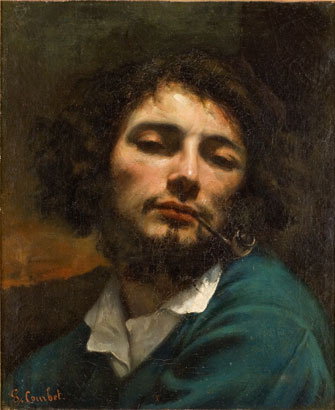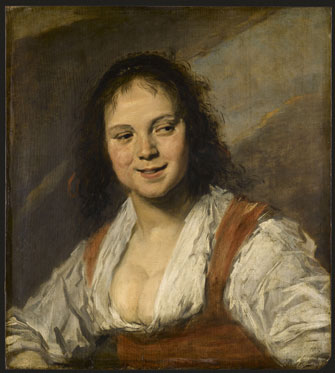Centuries of Stereotypes
Perpetrated by Artists

”L’Homme à la Pipe” (1846), a self-portrait by Gustave Courbet. © RMN/Agence Bulloz
The Grand Palais opened another of its entertaining and informative themed exhibitions last week. “Bohemians” starts out with an investigation of the history and meaning of this heavily loaded term. Like so many words, its connotations and those of its synonyms evolved from one misunderstanding to another, beginning with the mystery surrounding the origin of the traveling people we now call Roma.
First misnomer: in 1421, we are told, the records of the French town of Arras noted a marvelous occurrence: the arrival of strangers from Egypt (hence “Gypsies” in English), although the visitors actually came from an area known as Little Egypt in the Peloponnese. The identification of traveling groups of people as “Bohemians” got started because some had safe-conduct letters from Sigismund, king of Bohemia, not because they were from Bohemia, while the French term “tzigane” and the Italian “zingaro” derive from the Byzantine word “athinganos” and are based on confusion with a sect from Asia Minor.
All these misnomers were accompanied by a plethora of misconceptions about the so-called Bohemians, who were variously stereotyped as joyous, picturesque and fancy-free, with a lifestyle to be emulated, or dirty and thieving, to be avoided and feared.
The first floor of exhibition illustrates these contrasting beliefs with a multitude of artworks, starting with Leonardo da Vinci’s drawing “A Man Being Cheated by Gypsies (Five Grotesque Heads).” As the title indicates, there are two different interpretations of the meaning of this work, making its inclusion here dubious, although you can understand why it’s always good to throw in a Leonardo.
We have Gypsies as cheaters in Nicolas Régnier’s wonderful composition, “The Card Players” (c. 1625), in which the two main figures, a finely dressed man and woman, stare dreamily off into space while the sharpers examine the cards in their hands; and Georges de La Tour’s famous and perhaps even more marvelous “The Fortune Teller” (c. 1630), in which all five lavishly attired characters stand perfectly still with only their hands and eyes on the prowl.
The French artist Jacques Callot (1592-1635) offered another view of the lives of the Gypsies. After running away from home when he was only 11 years old, he was rescued by a troupe of Gypsies, with whom he lived for a time. He later immortalized their lifestyle in a series of engravings presented in the exhibition, which later provided inspiration for Baudelaire. Around the same time, Frans Hals painted his lively portrait, “Gypsy Girl” (or “Bohemian,” c.

“Gypsy Girl” (c. 1630) by Frans Hals. © RMN (Musée du Louvre)/ Jean-Gilles Berrizi
1630), of a laughing girl with a mischievous glint in her eye and a generously displayed bosom.
In the 17th century, bohemians were all the rage in the theater, and their music and dancing were appreciated even by kings. Henri IV was entertained by a troupe at Fontainebleau in 1607, and, in 1655, the Sun King himself, dressed in striped robes with his abundant hair down, played a Gypsy in a ballet.
The view of Gypsies as picturesque and romantic, encouraged by Jean-Jacques Rousseau, can be seen in an 18th-century pastoral scene from the school of François Boucher, in which the fortuneteller is no longer a thief, just a curiosity.
The exhibition turns into theater itself upstairs when we reach the 19th century, the heyday of the Romantics, who turned the term “bohemian” into an accolade and lived the lifestyle we still associate with the word today. The exhibition’s designers have gone all out to create fancy settings for the works of the 19th-century artists: re-creations of a café and a starving artist’s atelier (with the paintings displayed on easels), a tent filled with the letters and portraits of Verlaine and Rimbaud, a Morris column covered with posters for Bizet’s Carmen, etc. There is also a tribute to Puccini’s opera La Bohème and Henri Murger’s Scènes de la Vie de Bohème, the novel it is based on, which propagated the indelible image of those 19th-century artists starving in Montmartre garrets and their untenable lifestyle (many of them committed suicide — if they didn’t die of tuberculosis like Mimi — when artistic success did not come their way).
You’ll also find caricatures of the artistic bohemian by Honoré Daumier and Félix Régamey, along with many familiar and unfamiliar paintings. Here is Courbet’s self-portrait as the ultra-romantic bohemian (“Man with a Pipe,” pictured above), the famed “In a Café (Absinthe)” by Degas, works by Toulouse-Lautrec, Manet, Van Gogh and even a few minor works by Picasso.
All of the stereotypes depicted in the exhibition are very much alive today, and the Roma still excite curiosity and anxiety in the general populace in France. Just before the show opened, the new Socialist government had some Roma encampments razed, and “tziganes” are still generally feared as thieves in France, even while people flock to concerts of the enormously popular jazz manouche (“gypsy jazz” in English) based on the music of Django Reinhardt. Plus ça change…
Galeries Nationales du Grand Palais: 3, avenue du Général Eisenhower, 75008 Paris. Métro: Champs-Elysées Clemenceau. Tel.: 01 44 13 17 17. Open Wednesday-Monday, 10am-8pm; until 10pm on Wednesday. Admission: €12. Through January 14, 2013. www.rmn.fr.
Reader reaction: Click here to respond to this article (your response may be published on this page and is subject to editing).
Please support Paris Update by ordering books from Paris Update’s Amazon store at no extra cost. Click on your preferred Amazon location: U.K., France, U.S.
More reviews of Paris art shows.
© 2012 Paris Update
